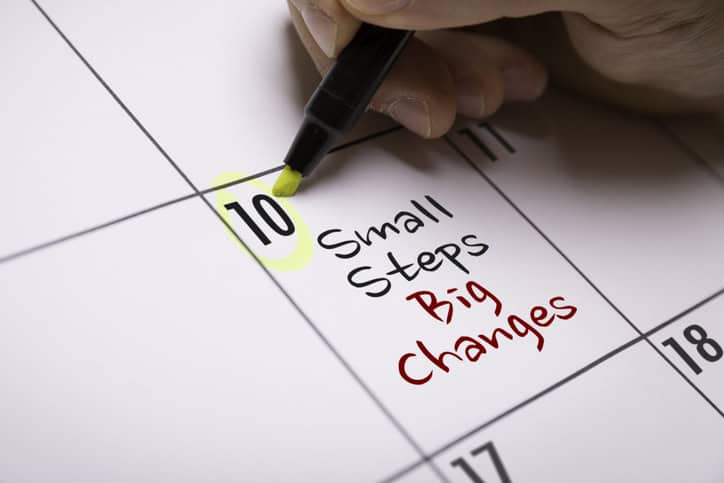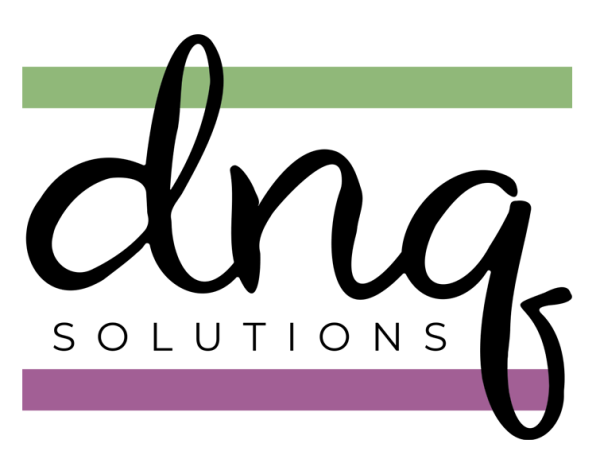
This post was originally published a little more than 10 years ago. I decided to update it because this past week I attended a conference hosted by the Institute for Challenging Disorganization (ICD). It was an amazing conference with fabulous presenters! Each one of those presenters touched (in their own way) on the concept that making incremental small steps leads to big and lasting changes.
KaiZen: small steps toward lasting change
I was first introduced to this concept in April 4, 2011. I took a class offered by the Institute for Challenging Disorganization titled Kaizen – The Next Step for the Chronically Disorganized Client. It was a fascinating class. Kaizen is a word which comes from two Japanese roots, kai which means change and Zen which means good. During this class I learned that when a person is taught how to make small changes toward a stated goal there is a better chance of success.
How does it work?
Do you wonder why that is true? Let’s think about this. I am going to use the example of a lifestyle change. Let’s say that someone wants to get in better shape. They decide they want to lose some weight and become more physically fit. They have been eating mostly fast food and have never been accustomed to regular exercise. The reason that they decided to make this change is that they want to be in better shape for their high school reunion.
The first method they try is a crash diet. This makes them hungry, cranky and generally out of sorts. They also decide to exercise at a local gym everyday. After one week of trying this method they abandoned the crash diet – good thing since that is not a healthy approach and they stopped exercising after day three because their muscles were so sore.
If I apply the Kaizen philosophy to this situation it would look something like this: they would sign up to work with a nutritionist. The nutritionist would teach them how to plan healthy meals. Every time they met the nutritionist would have a few more changes for them to make. They would feel full, enjoy the meals they are making and weight would come off slowly and steadily. Then, they would also sign up to work out with a trainer a few times a week.
The trainer would teach them some exercises which would make them stronger and tone their muscles. The trainer would also encourage them to incorporate other daily exercise into her routine. Things like walking, biking or swimming. The lesson here is that small incremental changes which are not too tough bring results and are easier to maintain.
Break projects down into small steps
During the ICD conference recently, Juliet Landau-Pope spoke about dyspraxia. We learned that organizing or doing tasks for long periods of time are truly taxing for someone with dyspraxia. That it’s better to tackle projects in small steps and for short amounts of time. She recommends working on a project for about 10 to 15 minutes. This means that to complete a project, you need to break it down into small steps. Then do one step at a time until the project is finished.
This concept of Kaizen, making small steps toward a stated goal is a fascinating one to me. So often we look at the big picture and want an instant result. Kaizen teaches you to slow down. To learn and incorporate the lesson of each step into that which you are working towards.
It takes time and energy to change a behavior or a habit. If you rush through a step to get the next step completed chances are you won’t have adequately learned the previous step. Read more about this concept of taking small steps in this post.
Alma Galvan gave the final presentation of the conference. It was fascinating to learn that when babies skip through developmental steps, parts of the brain are left under-developed. The good news is that now that we know this, there are ways to go back and develop those parts of the brain. She showed us exercises to use to access parts of the brain and to encourage communication between these parts of the brain.
In conclusion
It may feel like taking small steps is wasting time but really these small steps are vitally important. We learn better when we process information in small bites. We accomplish more when we do things a little bit at a time because we are focusing our attention on that small task. Then the small tasks add up and, viola! A large task is completed.
updated; October 17, 2021
Diane N. Quintana is a Certified Professional Organizer. She is the owner of DNQ Solutions, LLC and Co-owner of Release Repurpose Reorganize, LLC. Diane and Jonda are the creators of the unique time-based deck of cards: Organize Your Home 10 Minutes at a Time.


I love the Kaizen approach and can see why similarly-themed approaches (like Atomic Habits) work so well. A bite-sized approach creates less anxiety. I use Duolingo to learn Italian; I didn’t study it in college (though I wanted to) for fear that it would be difficult, that I wouldn’t be able to put in the time, and that it would mar my “permanent record.” Now, I can happily do one 20-item lesson in a category and be done. In the beginning, only having to spend five or ten minutes to make inroads made my fears evaporate and now I can joyfully sit for an hour practicing (and grumbling about the past imperfect tense or conditional mood). I love how you explain the concept in a way that makes eminent sense. Calling it “breaking things down into baby steps” helps, but the rubric of Kaizen will appeal especially to those in business and anyone wanting to explore it more formally (in teeny, tiny ways).
Another member of the Kaizen Club here, Diane! I have an ongoing decluttering challenge for subscribers where the challenge is to send away one item a week. Just one and then you’re done. As you point out here, it’s very hard to maintain resistance and overwhelm when the task is that doable. People scoff at the idea, think they’ll never get rid of the clutter that way, and then tell me how the habit grew and grew and GREW!
I always found that small changes stuck more than drastic ones. Little changes over time allow us to adjust and add them to our activities.
When working with clients, I also used this method, only organizing with clients between 2 – 4 hours per session. This method allowed them to focus on the area resulting in a well-organized space in which the client knew everything that was in it. Also, my clients appreciated the shorter time because it didn’t tire them too much and allowed them to be focused on the area. Thanks for sharing this topic.
Now I can put a name to the ‘break it down’ system! I’m always advising my clients to ‘break it down’ (whatever their ‘it’ is) into the ‘teeniest-tiniest’ steps possible. Sometimes they look at me as if I’m crazy but I assure them that sticking to a roadmap filled with teeny-tiny steps will get them to their goal much more easily than taking a few giant leaps. Thanks for sharing the concept of KaiZen with all of us.
It was wonderful seeing you at the conference. I’m glad we ended up in some of the networking rooms together. And HUGE thank yous (and Jonda) for being conference sponsors. ICD is so fortunate to have your participation and support in all ways.
I remember that course about kaizen. Didn’t Kathy England present it? It was the first time I heard about that concept, and it has stuck with me ever since. I love how you related kaizen to two other wonderful sessions at the conference. Juliet’s and Alma’s were favorites of mine. One of the things I appreciate about virtual organizing is the work with small changes. The nature of working in shorter, more regular sessions supports this work. The clients start to own what’s possible and see what can be accomplished in a short amount of time.
On a personal note, I’ve been working on a ‘live with less’ pursuit. It started with my physical home and now has morphed into working on myself. It’s so clear that great change doesn’t happen overnight, but with tiny, incremental steps and a lot of good support bigger changes happen.
I found this to be true in my personal exercise regime. I originally started with about 7 minutes in the morning to do some stretching and core exercises to protect my back while working. Once I was down there, and had gotten used to the idea of a few minutes in the morning, it felt easier to add a bit each week. And I mean a BIT. As in “one more sit-up” each week. Funny thing is, now it has been many years, and it isn’t unusual for me to be down there for more than an hour. It never felt like I was heaping on more than I could handle because the changes were so small.
thanks for sharing this update!